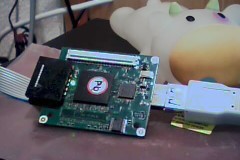usb_serial is a synthesizable VHDL core, implementing data transfer over USB. Combined with an external transceiver chip, this core acts as a USB device that transfers a byte stream in both directions over the bus.
The core is intended for FPGA projects where a simple (RS232-like) interface to a PC is needed. Higher data rates are possible with USB than with standard RS232, especially when high-speed USB 2.0 mode is used.
Note: An external USB 2.0 transceiver chip is required between the core and the actual USB lines. This transceiver must be compatible with the UTMI standard.
Download
| Package | File |
|---|---|
| VHDL files (latest version) | fpga_usb_serial_20131205.tar.gz |
| Manual for VHDL core (latest version) | fpga_usb_serial_manual.pdf |
| VHDL files (version 2011-10-04) | fpga_usb_serial_20111004.tar.gz |
| Older VHDL files (version 2009-10-06) | fpga_usb_serial_20091006.tar.gz |
| Older VHDL files (version 2007-04-19) | fpga_usb_serial_20070419.tar.gz |
This package is free software; you can redistribute it and/or modify it under the terms of the GNU General Public License as published by the Free Software Foundation; either version 2 of the License, or (at your option) any later version.
Features
- Very simple application interface that passes one byte at a time. Complications involving the USB protocol (packets, endpoints, descriptors) are handled within the core. This is in fact the whole point of this package.
- UTMI-compatible transceiver interface.
- Supports USB 2.0 in full-speed (12 Mbit/s) and high-speed (480 Mbit/s) modes.
- No special driver is needed on the computer.
The core is compatible with the Communication Device Class (CDC-ACM) and works with generic CDC-ACM drivers provided by Linux, Mac OS X and Windows.
Note: On Windows, a custom INF file is needed.
Note: Custom drivers are needed for optimal performance in high-speed mode. - Tested on a Xilinx Spartan-3 FPGA.
Works out-of-the-box on a Trenz TE0146 micromodule.
The latest version (2011-10-04) adds support for strings describing manufacturer, product, and serial number in the USB device descriptor.
Documentation
See the manual.
Note: If this design is synthesized as a Xilinx ISE Project, the use of IOB flip-flops should be enabled for correct timing of I/O signals. (Process properties → Map → Packing of IOB registers = Input and output).
Contact
Comments, suggestions, bug reports are welcome at joris @ jorisvr.nl

